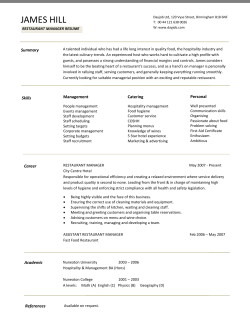
Restaurant Industry Organization: Chain, Independent, or Franchise? Chapter 5
Chapter 5 Restaurant Industry Organization: Chain, Independent, or Franchise? Copyright © 2010 by John Wiley & Sons, Inc. All Rights Reserved RESTAURANT INDUSTRY ORGANIZATION • This chapter will focus on restaurant company organization—that is, how companies are organized • This is important to know because there are significant differences between chains (corporate), independents, and franchises • Currently, the industry growth is being driven by chains so we will start with them CHAINS • Chains have strengths in seven areas: • • • • • Marketing and brand recognition Site selection Access to capital Purchasing economies Centrally administered control and information systems • New product development and • Human resource development CHAINS Marketing and Brand Recognition • Chains are able to achieve a high level of brand recognition by keeping their messages simple, large marketing budgets and the additive effect (repeating the message) • The large cost of the marketing a national company is spread among a large number of units CHAINS Site Selection Expertise • Much of a restaurant’s success is owed to choosing the proper site • It has become much more competitive to identify suitable sites • Choices are based upon a thorough examination of the feasibility of the site CHAINS Access to Capital • This can be a challenge because of the rising costs of opening a restaurant coupled with lenders’ view that the restaurant business is risky • Options include loans from banks, friends and family, personal savings, limited investors, “going public” CHAINS Purchasing Economies • The power of purchasing large quantities for distribution among different locations or entering into a contract with a company for multiple individual purchases • When one considers that food is a primary expense, the savings of 1% – 2% can be significant CHAINS Control and Information Systems • Chains can also afford to purchase expensive systems with the justification that the cost will be spread across multiple units • Contrast this with the challenge of an individual operator purchasing a system beyond his or her means CHAINS New Product Development • This is only becoming more important as competition increases • Large chains can afford to staff and equip development kitchens CHAINS Human Resource Program Development • Again, the cost of recruiting, hiring, training, and developing is spread across multiple units • Also, human resource expertise can be centralized • There can also be disadvantages CHAINS • Largely as a result these strengths, chain domination (as measured by market share) has grown over the last several years • The top 100 chains alone generate over 50% of all restaurant sales • This domination has increased from just 33% in 1975 ADVANTAGES AND DISADVANTAGES • Advantages, disadvantages for franchisees • Advantages and disadvantages for franchisors
© Copyright 2025




















